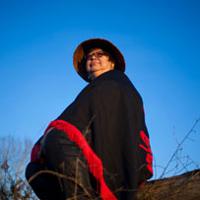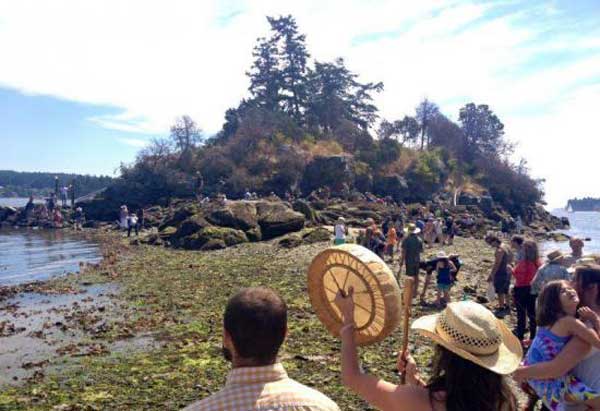First Nations burial sites on private property are front and centre again. This time it is Grace Islet in Salt Spring Island's Ganges harbour where a property owner wants to build his home over gravesites.
Previously, the issue of the Musqueam First Nation and cesnaʔəm (also known as the Marpole site) dominated the news for many months in 2012 and 2013 until the Musqueam purchased the property from the developer.
Throughout the Musqueam dispute the province stated it had no tools to deal with the situation. In reality, there are many tools available under the common law and the Heritage Conservation Act (HCA); B.C. just doesn't want to use them. The HCA provides for denial of permits, agreements for First Nations to manage their own heritage sites, and even for purchase of sites to protect them. After the Musqueam situation was resolved, the province did not bother to work with First Nations to activate the available tools or find new ones to avoid similar conflicts in the future.
We see the same tragic and unnecessary story unfolding at Grace Islet. Provincial Minister Steve Thomson stated B.C. is taking all precautions necessary to ensure the landowner "works around" the burial sites, and that this is set out in permits. However, recent photos show cement foundations and walls built on top of three of the burial cairns. Obviously, there is no provincial monitoring and the permits are "toothless." No charges have been laid for the violation of the permits.
Similar stories are playing out in the densely populated Fraser Valley on Sumas Mountain, the Chilliwack Valley and elsewhere. This will happen again and again as there are hundreds of First Nation burial sites. B.C must deal with this.
Protection as colossal failure
Historically, First Nations created burial grounds as part of their continuous occupation of the land. Unfortunately, B.C. parceled out private property over top of First Nations' burial grounds. In 1867 B.C. passed the Indian Graves Ordinance protecting "Indian Graves" from disturbance by settlement and claiming ownership of burials as "property of the Crown." Under federal law and policy, burial sites were supposed to be protected as Indian reserves but most were not. Canada and B.C. tried to pass legislation to take control of First Nation cemeteries to "protect" them. This protection has been a colossal failure.
Currently, the minister has the power to suspend, amend or cancel alteration permits once issued in certain circumstances. Suspending permits gives the developer more incentive to work with the First Nations to find solutions. With Grace Islet he has refused to use these powers. In his editorial to the Times Colonist dated July 23, 2014, Minister Thomson says that First Nations burial sites are not protected because they are not a cemetery under the Cremation, Interment and Funeral Services Act. You have to be an "owner" of a cemetery to have it included under the law.
We invite Minister Thomson and the provincial cabinet to review the Supreme Court of Canada's ruling in the Tsilhqot'in title case. The court granted the Tsilhqot'in title to nearly one million acres of land. This was based on the Tsilhqot'in's use and occupation of the land prior to the establishment of Canada. Burial sites were recognized as part of the title area. For example, the trial judge stated "Xexti is a Tsilhqot'in burial place near Xexti Biny (Nemiah Lake). It is not on reserve... generations of Setah family members are said to be buried at this site dating back to Old Sit'ax (Louie Setah)." We further expect at the Sept. 11 meeting between Premier Clark, her cabinet and B.C. chiefs that substantial dialogue will occur with respect to the implementation of the Tsilhqot'in decision and the provincial government's approach to Aboriginal title territories and protection of First Nation heritage sites.
It is time to move past old prejudices dressed up in tired legal arguments. None of us should accept the proposition that it is ok to bulldoze First Nation burial sites just because they are not technically considered "cemeteries" under provincial law. It's time for all British Columbians to recognize that First Nation burial sites are owned by First Nations and that First Nations have duties under their own traditional laws to respect and protect their ancestors.
Preventing further problems
What can be done to prevent these conflicts from repeatedly arising?
The province must implement the Tsilhqot'in decision and recognize First Nation ownership of their burial, cultural, spiritual and other heritage sites. Ownership by First Nations provides additional tools to resolve issues through solutions developed by First Nations themselves, not the provincial government. This includes potential access to federal resources through their fiduciary obligation to First Nations land. Experience has shown that where First Nations are enabled to make the decisions, they are sensitive to their neighbours and are able to find creative solutions that work for everyone including relocations, shared caretaker arrangements and sometimes buy-outs.
B.C. should stop stalling and should conclude agreements with First Nations under Section 4 of the HCA so First Nations can manage their sites whether these sites are on private lands or not.
B.C. could work with First Nations to amend the HCA to confirm First Nation ownership of sites and to ensure alteration permits are not issued without the consent of the First Nation. First Nations and B.C. could develop a process or fund for landowners who feel their issues have not been addressed.
The Joint Working Group on First Nations Heritage Conservation is a group of representatives from First Nations and the provincial government. Over the years this group has been working diligently to resolve issues with First Nations heritage conservation. This work has been hampered by limiting provincial mandates. If there were political will from B.C., this group could be assisting First Nations, landowners and the province in resolving these issues.
A legal and moral imperative
To those who say it is unworkable to have layered ownership and jurisdiction on private property, we remind them to look at the current reality of land ownership in B.C. No property ownership is absolute. B.C. owns subsurface minerals and oil and gas and regulates groundwater. Hydro, railways and utilities have rights-of-way. Municipalities regulate tree cutting, construction and many other aspects of ownership. Most land in B.C. is subject to Aboriginal title claims. Recognizing First Nation ownership of burial and heritage sites is consistent with recognizing the realities of all of the existing layers of ownership and jurisdiction.
Protection of First Nation burial sites at Grace Islet has increasing support from many citizens, groups and the CRD. Funds are being raised to try and purchase the land. If the province would support these efforts, the conflict could be resolved at Grace Islet and provide a model for everyone working together.
It is a legal and moral imperative that provincial leaders move away from old prejudices that First Nation burial sites are less worthy of protection than settler cemeteries. It's time to put protection of burial sites back into the hands of the people whose ancestors have been laid to rest at these sacred sites. It's time for us all to work together to find solutions. ![]()
Read more: Indigenous
















Tyee Commenting Guidelines
Comments that violate guidelines risk being deleted, and violations may result in a temporary or permanent user ban. Maintain the spirit of good conversation to stay in the discussion.
*Please note The Tyee is not a forum for spreading misinformation about COVID-19, denying its existence or minimizing its risk to public health.
Do:
Do not: